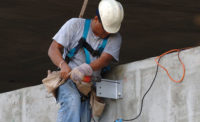The construction industry was at the receiving end of most of the agency’s scrutiny, and for good reason. In 2013, falls were the leading cause of worker deaths on construction sites, accounting for 294 fatalities out of 796 total fatalities in construction.
Of 5,842 inspections conducted among specialty trade contractors, 6,011 citations were issued and $17,220,055 in fines levied. The building construction industry came in for 893 fall protection-related citations and $2,086,696 in penalties. Heavy and civil engineering construction’s 55 citations derived from 52 inspections and brought with them $175,941 in penalties.
Noncompliance of 1926.501 was also found in the merchant wholesalers, durable goods industry, which received $122,442 in penalties; fabricated metal product manufacturing ($29,335); waste management and remediation services ($25,631); administrative and support services ($17,203); real estate ($10,020); machinery manufacturing ($14,637); utilities ($20,223) and accommodation ($9,695).
What the standard says
OSHA’s fall protection standard for the construction industry requires employers to determine “if the walking/working surfaces on which its employees are to work have the strength and structural integrity to support employees safely. Employees shall be allowed to work on those surfaces only when the surfaces have the requisite strength and structural integrity.” Additionally, employees on walking/working surfaces with an unprotected side or edge that are six feet or more above a lower level must be protected from falling by use of guardrail systems, safety net systems, or personal fall arrest systems.
At the core of OSHA’s nationwide outreach campaign to raise awareness about the hazards of falls are three steps:
PLAN how the job will be done, what tasks will be involved, and what safety equipment may be needed to complete each task.
PROVIDE fall protection and the right equipment for the job for workers who are six feet or more above lower levels. If roof workers use personal fall arrest systems (PFAS), a harness must be provided for each worker who needs to tie off to the anchor. Additionally, the PFAS must fit and all fall protection equipment be inspected regularly to ensure it’s in good condition and safe to use.
TRAIN workers in hazard recognition and in the care and safe use ladders, scaffolds, fall protection systems, and other equipment they’ll be using on the job. OSHA offers numerous materials and resources1 that employers can use during toolbox talks to train workers on safe practices to avoid falls in construction.
Additionally, a Stop Falls Web page2 has information in English and Spanish on fall protection standards.





